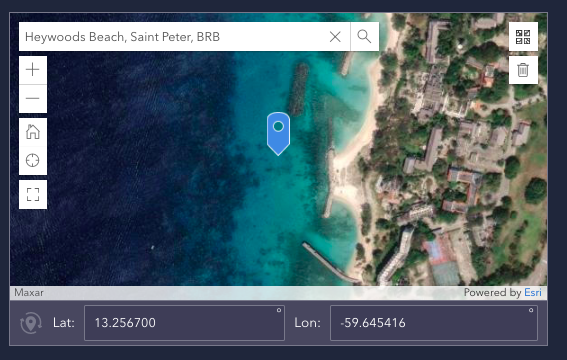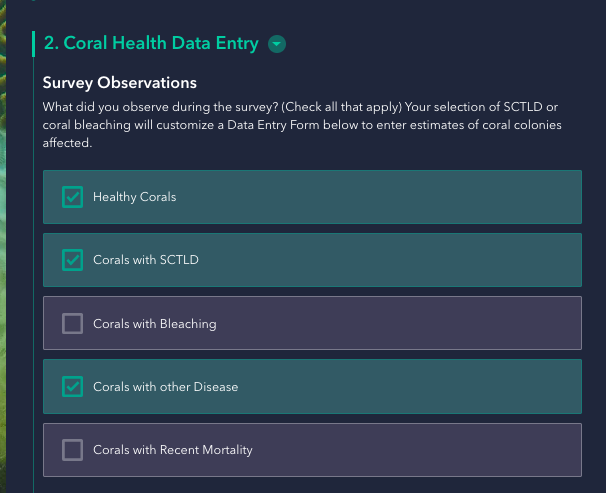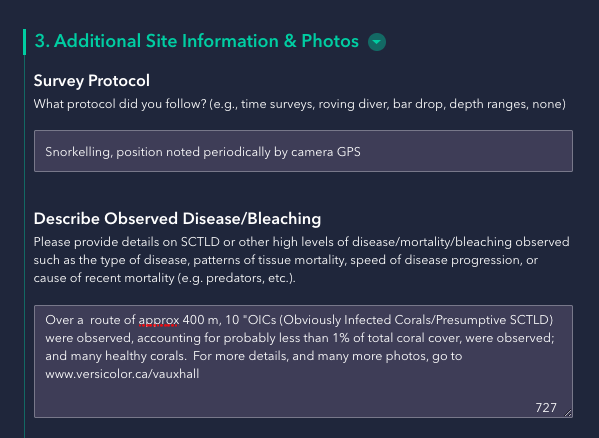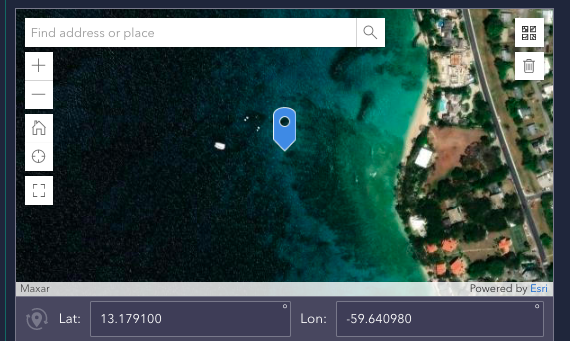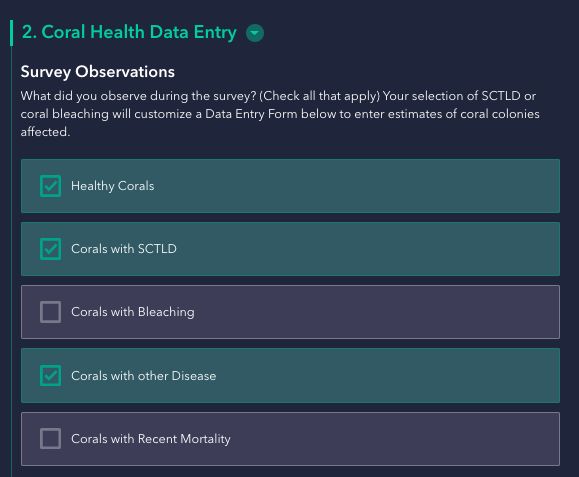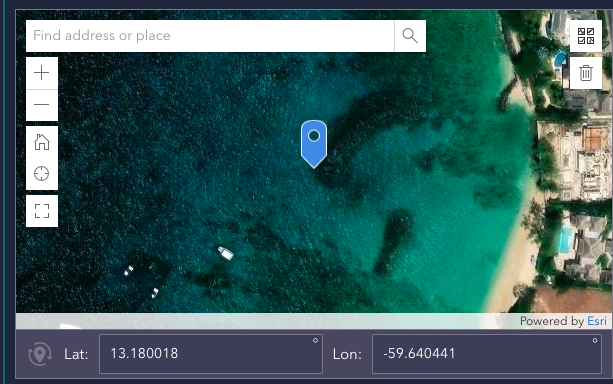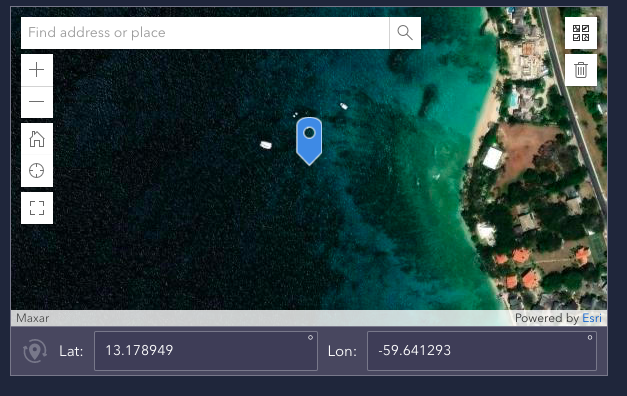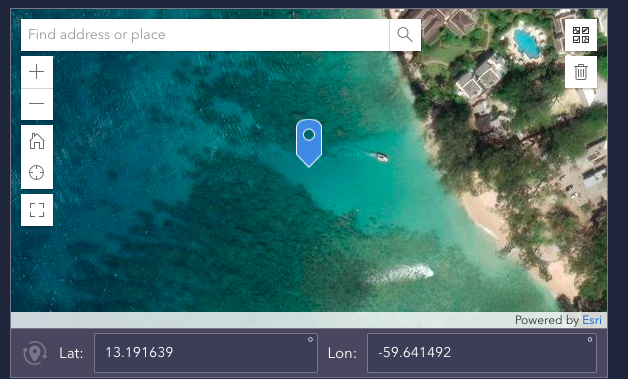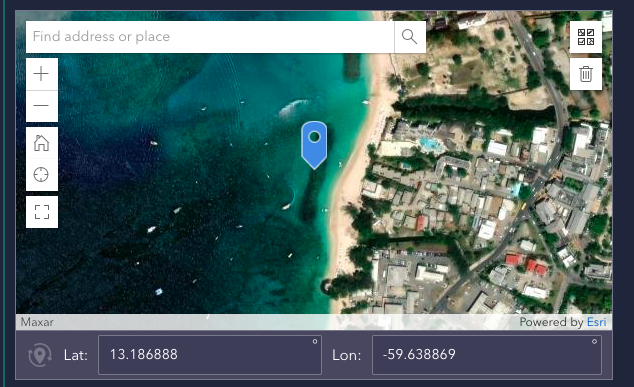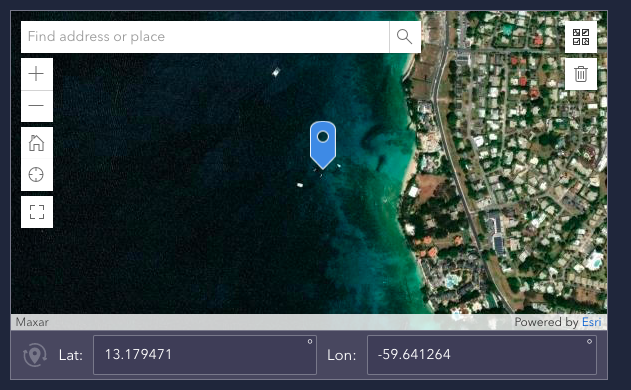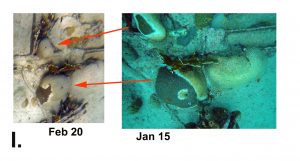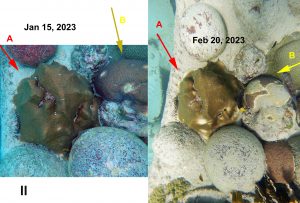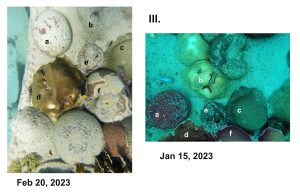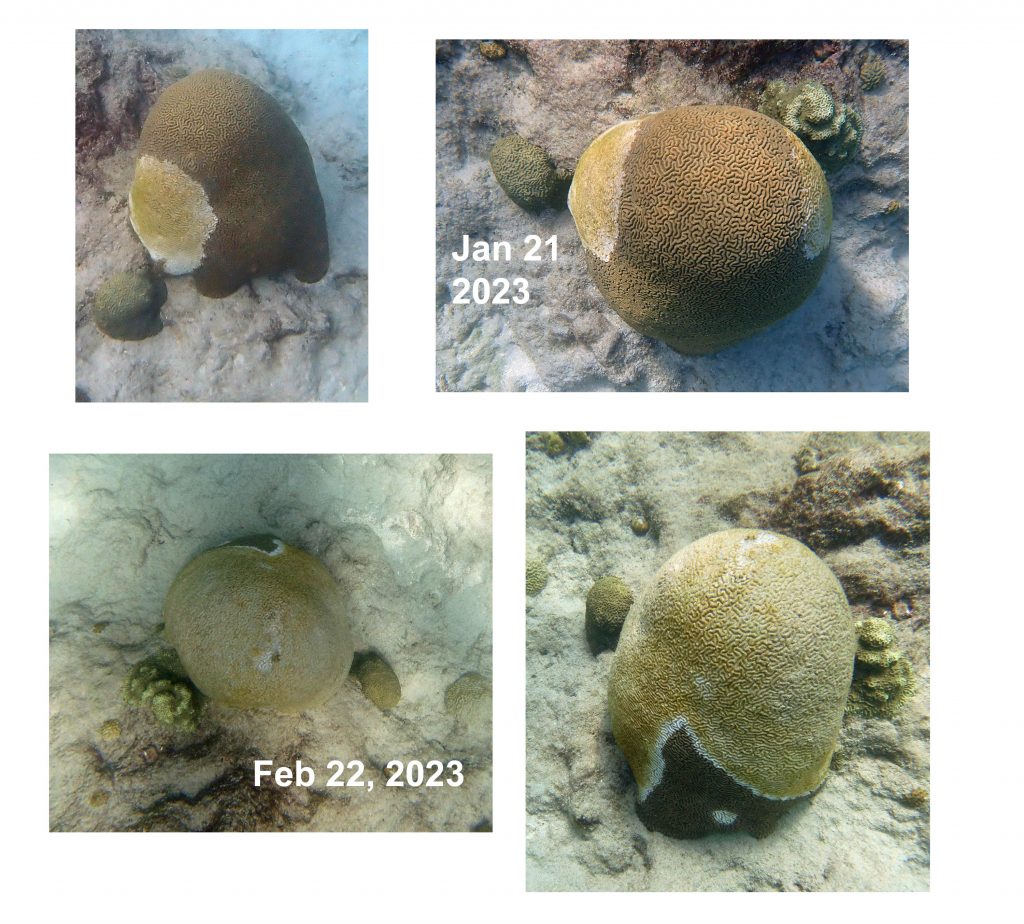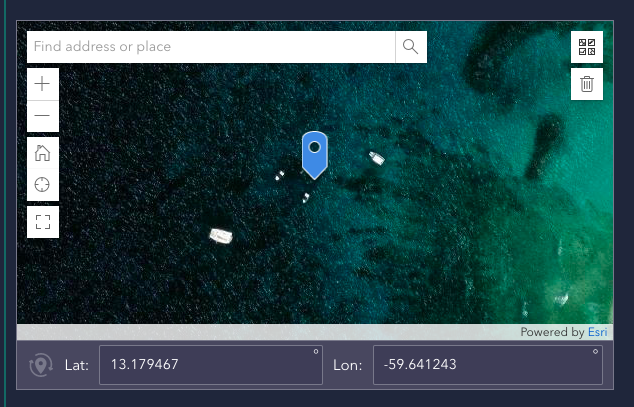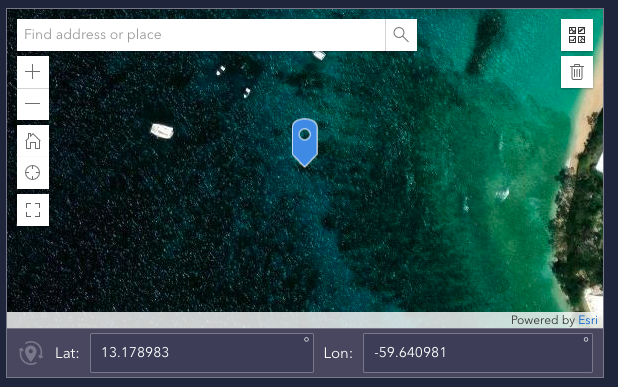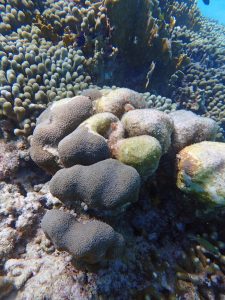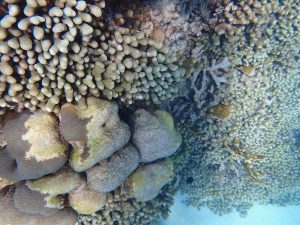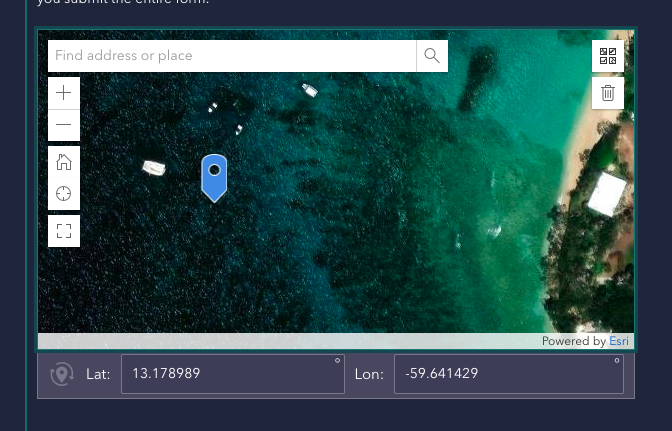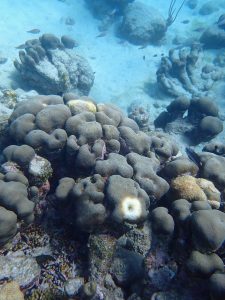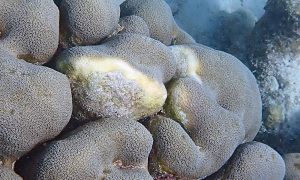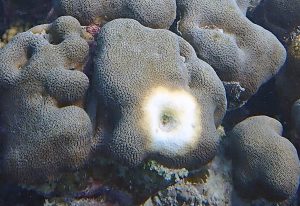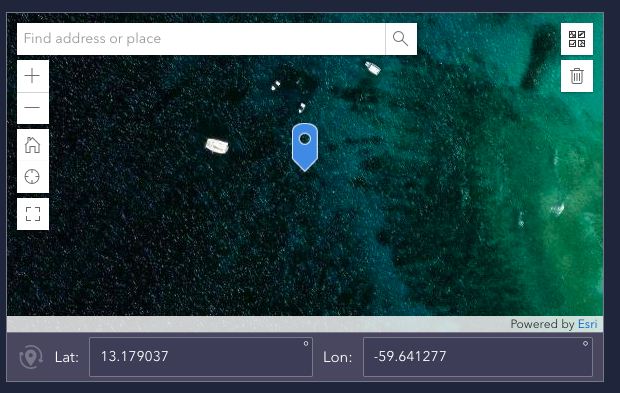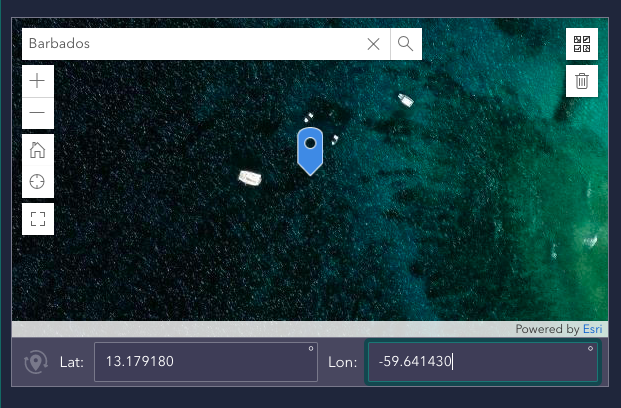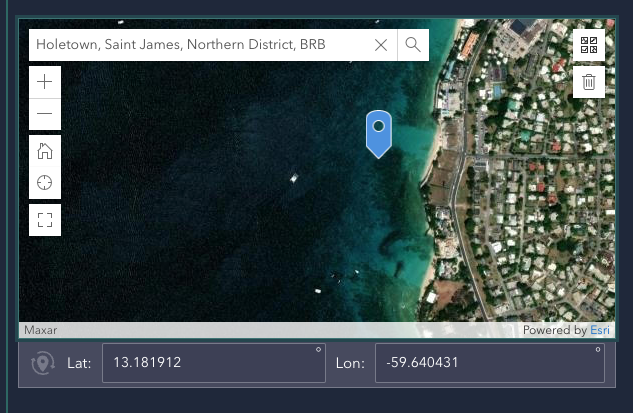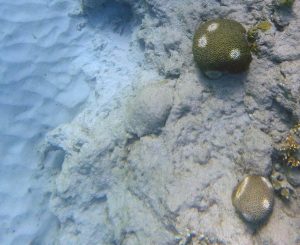Latest report submitted on Apr 18, 2023 (now 26 separate reports in total)
Note: Some of the coral IDs need verification/are possibly incorrect.
See Also
– Presumptive Stony Coral Tissue Loss Disease on Vauxhall Reef & Environs
– Notes & More Observations
EXTRACTS FROM MY (D. Patriquin) REPORTS TO AGRRA
AGRRA Rep 1 (Extract)
Date of Observation: 1/21/2023 Submitted 1/23/2023. But not on AGRRA Map on Feb 26.
Reef Type: Fore Reef
Abg Depth 2.5 m (estimated)
Water Temp 24 (estimated)
Reef Name: Vauxhall
Location:
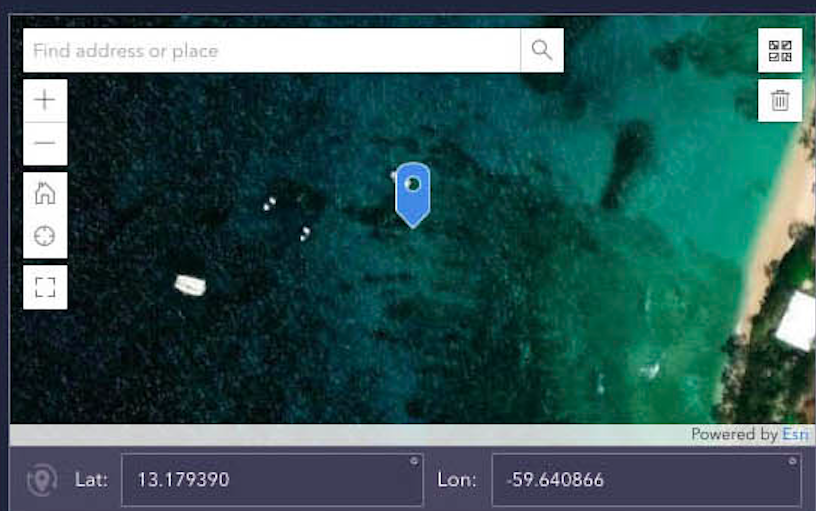
Survey observations: Healthy Coral and Corals with SCTLD
Describe Observations:

Photos
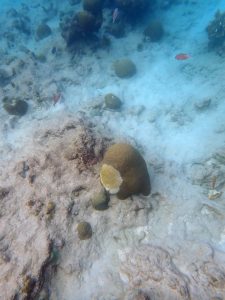 Photo 1 |
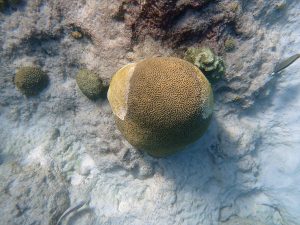 Photo 2 |
 Photo 3 |
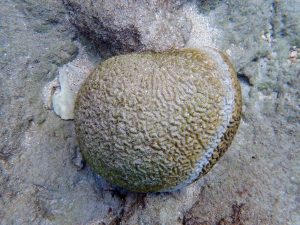 Photo 4 |
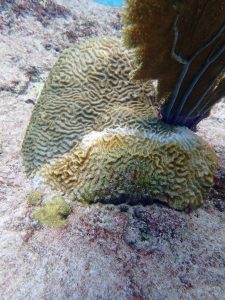 Photo 5 |
AGRRA Rep 2 (Extract)
Date of Observation: 1/11/2023 Submitted 1/23/2023//apparently deleted from AGRRA map on Feb 26 when I uploaded another set of observations in the same location.
Reef Type: Fore Reef
Abg Depth 3 m (estimated)
Water Temp 25 (estimated)
Reef Name: Vauxhall
Location:
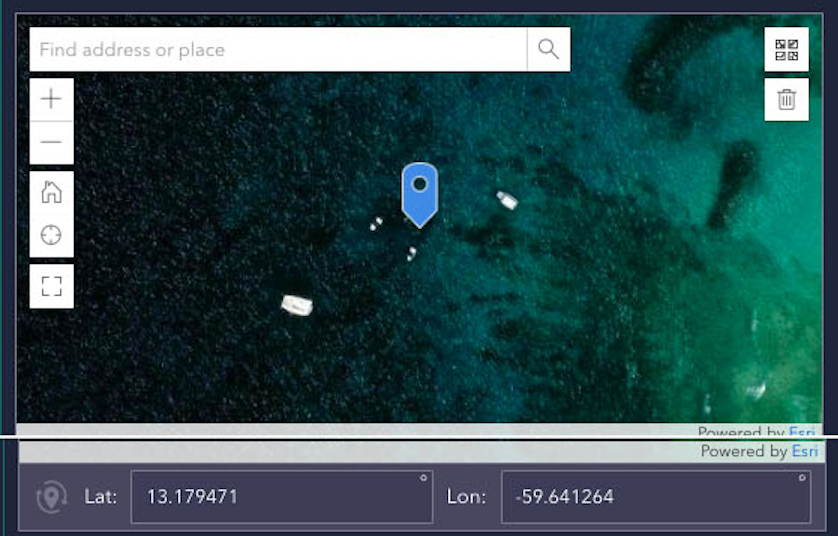
Survey observations: Healthy Coral and Corals with SCTLD
Describe Observations:
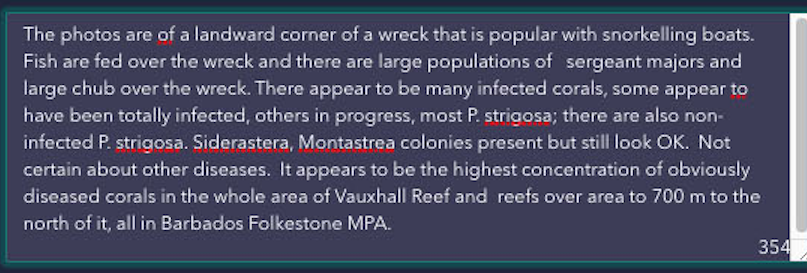
Photos
 |
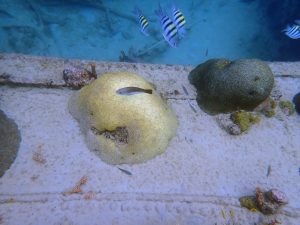 |
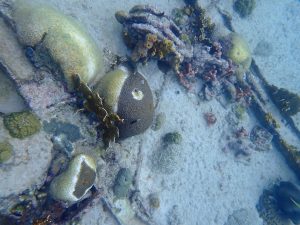 |
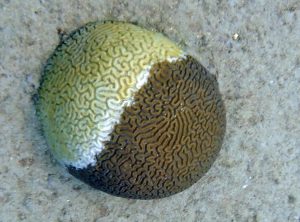 |
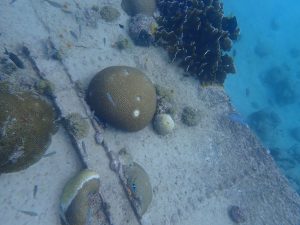 |
AGRRA Rep 3 (Extract)
Date of Observation: 1/14/2023 Submitted 1/23/2023
Reef Type: Fore Reef
Abg Depth 5 m (estimated)
Water Temp 25 (estimated)
Reef Name: Vauxhall
Location:
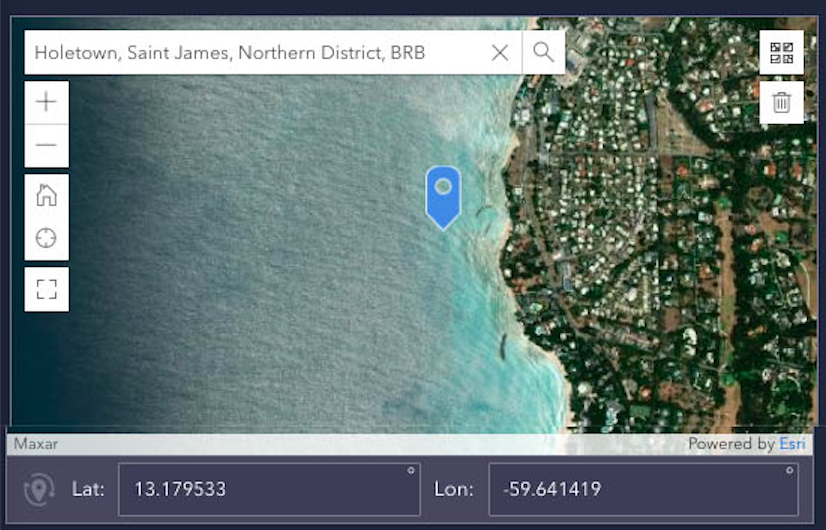
Survey observations: Healthy Coral and Corals with SCTLD
Describe Observations:
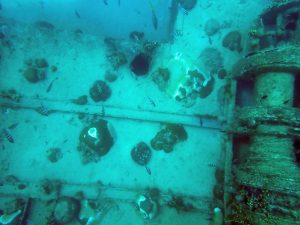 |
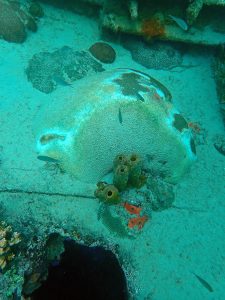 |
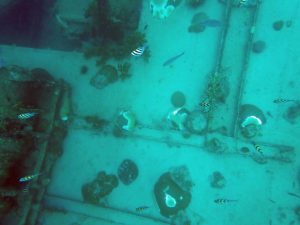 |
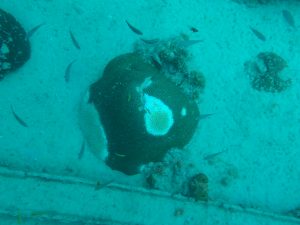 |
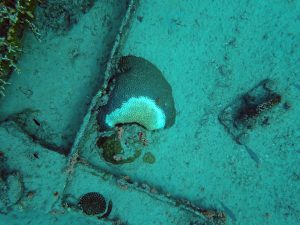 |
AGRRA Rep 4 (Extract)
Date of Observation: 1/31/2023 Submitted 2/9/2023
Reef Type: Other
Avg Depth 4 m (estimated)
Water Temp 24 (estimated)
Location: Heywoods Beach area, St. Peter Parish, Barbados
Survey observations: Healthy Corals
Describe Observations:

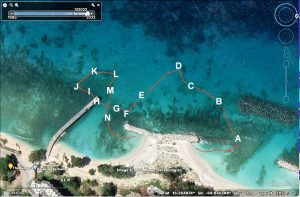 |
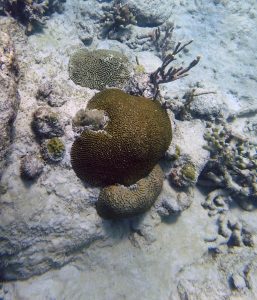 |
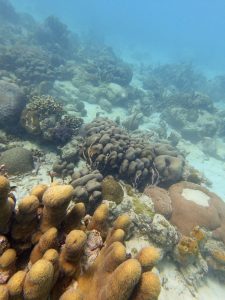 |
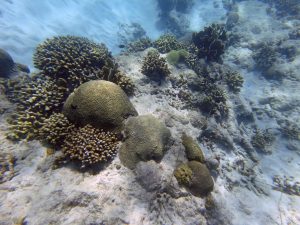 |
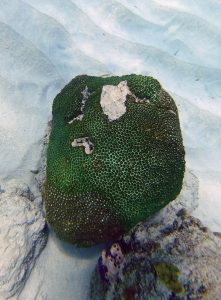 |
AGRRA Rep 5 (Extract)
Date of Observation: 1/29/2023 Submitted 2/11/2023
Reef Name: Vauxhall Reef, Holetown, St. James Parish, Barbados
Reef Type: Other. The survey route crossed the BackReef, through the Reef Crest onto the fore reef and back again; see first photo
Avg Depth 2m (estimated)
Water Temp 24 (estimated)
Location:

Corals with Stony Coral Tissue Loss Disease:
P. strigosa 6-25 colonies range
O. faveolata 1-5 range
Photos of Observations
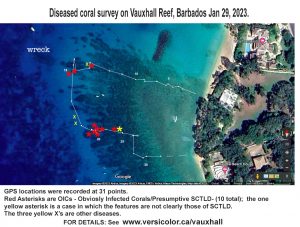 |
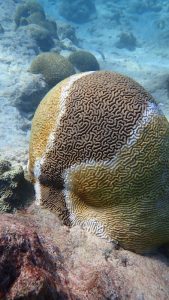 |
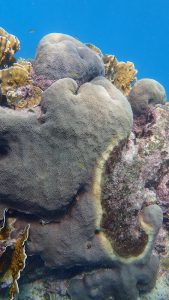 |
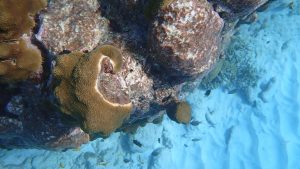 |
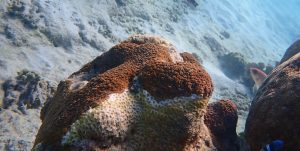 |
AGRRA Rep 6 (Extract)
Date of Observation: 2/8/2023 Submitted 12/2/2023
Reef Type: Fore Reef
Avg Depth 2.5 m (estimated)
Water Temp 24 (estimated)
Reef Name: Vauxhall
Reef Name: Vauxhall Reef Reef Type: Fore Reef
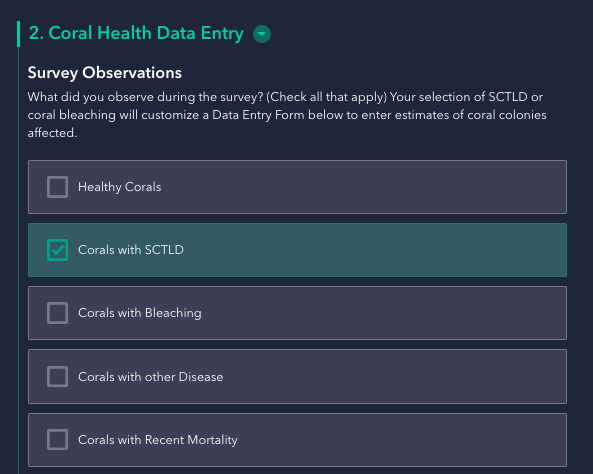
Species etc ” O. annularis, 1-5 Colonies with [presumptive] SCTLD
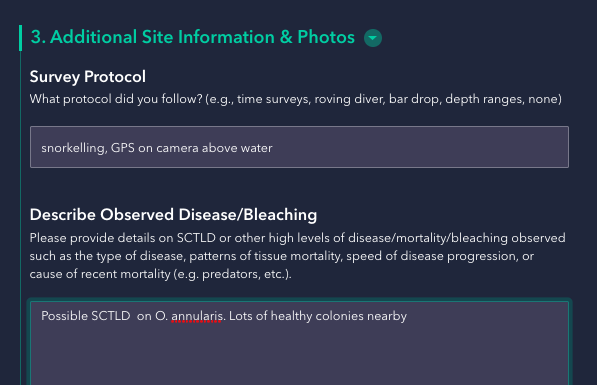
Photos
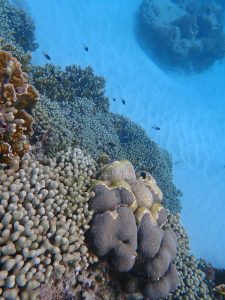 |
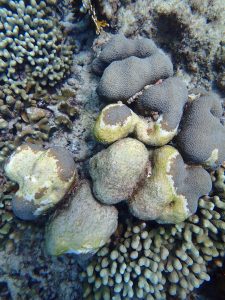 |
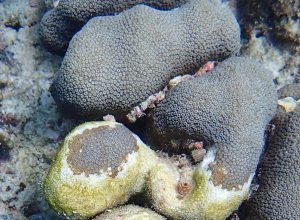 |
AGRRA Rep 7 (Extract)
Date of Observation: 2/8/2023 Submitted 2/12/2023
Reef Type: Fore Reef
Avg Depth 3 m (estimated)
Water Temp 24 (estimated)
Reef Name: Vauxhall
Location:
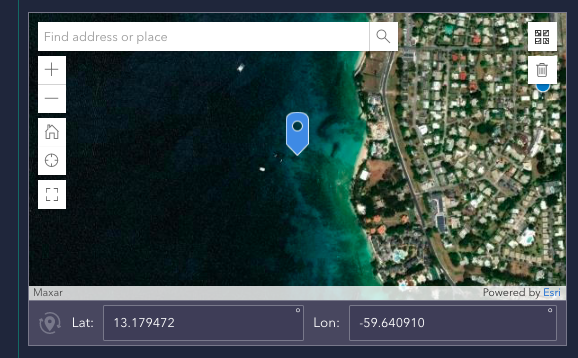
Reef Type: Fore Reef
Survey Observations What did you observe during the survey? (Check all that apply): Healthy Corals
Survey Protocol: Snorkelling, Location by camera GPS above water. Depth, temperature are estimated
Describe Observed Disease/Bleaching: I attach 2 photos of healthy pillar corals at this location. Pillar corals are fairly common on this reef, I have seen no sign of any disease on them. I assume this is of interest as I understand Pillar Coral is Highly Susceptible to SCTLD; I have submitted reports of other species on this reef with presumptive SCTLD
Photos
 |
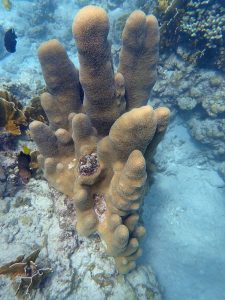 |
AGRRA Rep 8 (Extract)
Date of Observation: 1/13/2023 Submitted 2/12/2023
Reef Type: Fore Reef
Abg Depth 3 m (estimated)
Water Temp 24 (estimated)
Reef Name: Reef No 32 in MacLean & Oxendford 2016. Holetown, Barbados
Location
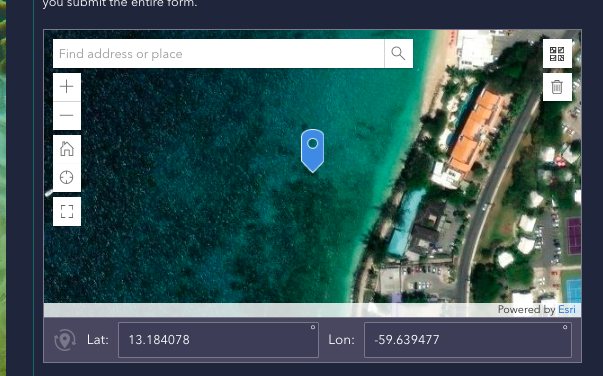
Reef Type: Fore Reef
Coral Health Data Entry Survey Observations What did you observe during the survey?: Coral with SCTLD (presimptive)
SCTLD Observations: Corals with stony coral tissue loss disease
Please mark which genus/species of corals showed signs of SCTLD. Provide the number of colonies observed if known.
Dichocoenia stokesii: DSTO (Elliptical Star)*** 1-5 colonies (1 only)
Diploria labyrinthiformis: DLAB (Grooved Brain)*** 1-5 colonies (1 only)
Meandrina meandrites: MMEA (Maze)*** 1-5 colonies (1 only)
Survey Protocol: Snorkelling. Location by eye/knowledge of the reefs etc
Describe Observed Disease/Bleaching: Presumptive. These were the only “obviously Infected Corals’/presumptive SCTLD I observed on this day as I swam along the seaward edge of this fringing reef. Nit certain about ID of D. stokesii
Photos
 |
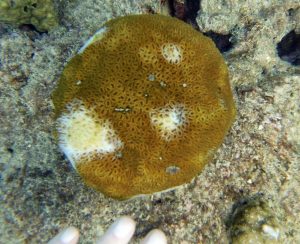 |
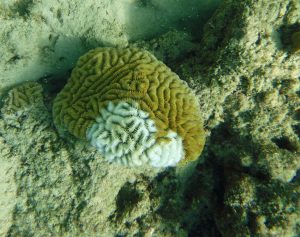 |
AGRRA Rep 9 (Extract)
Date of Observation: 2/12/2023 Submitted2/15/2023
Reef Type: Fore Reef
Abg Depth 3 m (estimated)
Water Temp 22 (estimated)
Reef Name: Reef # 33 in Folkestone MPA (Barbados)
Location
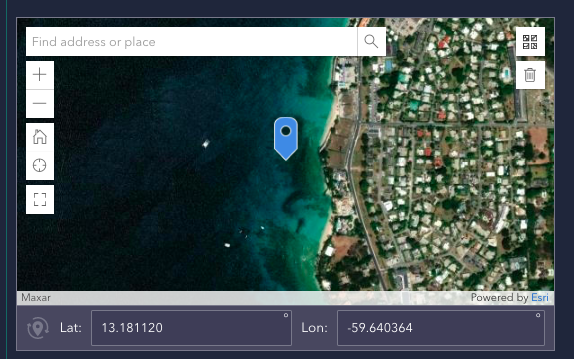
Reef Type: Fore Reef
SCTLD Observations: Corals with stony coral tissue loss disease
– M. cavernosa 1-5 colonies
– P. strogosa 6-25 colonies
– Siderastera siderea 1-5 colonies
Survey Protocol: snorkeeling along seaward edge of fringing reef
Describe Observed Disease/Bleaching: Snorkelled edge of Reef #33 (see ap in photos), total of 11 OICs (Obvioulsly Infected Corals), 8 were P. strigosa with presumptive SCTLD, one was S. siderea with Dark Spot, one was S. siderea with presumptive SCTLD and one was M.cavernosa with premumptive SCTLD. There is not a great abundance of corals along this reef, prob due to storm water outfall, guess circa 150 total over this route
Photos
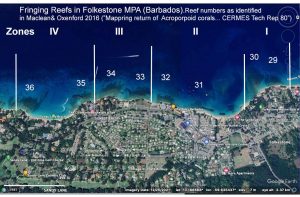 |
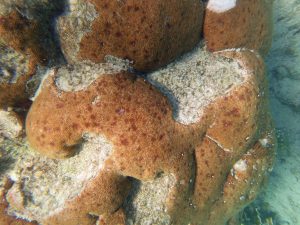 |
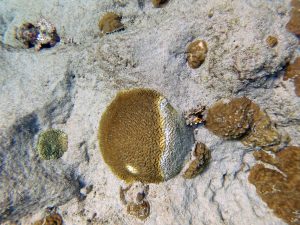 |
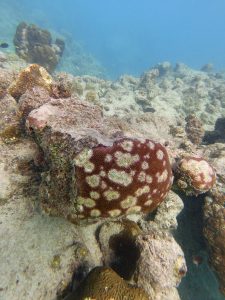 |
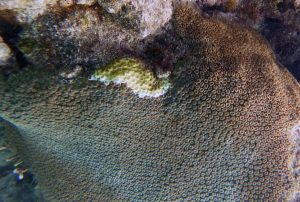 |
AGRRA Rep 10 (Extract)
Date of Observation: 1/27/2023 Submitted 2/13/2023
Reef Type: Other
Avg Depth 6 m (estimated)
Water Temp 24 (estimated)
Location
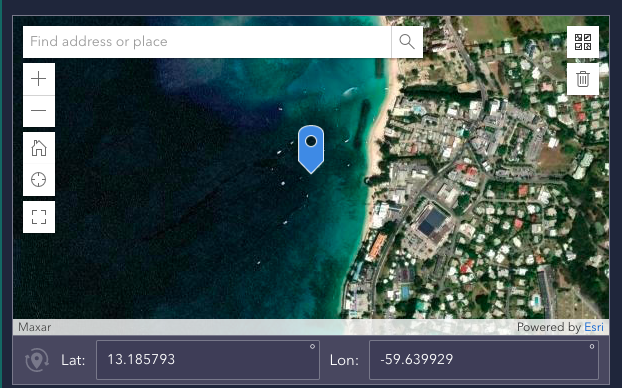
Reef name: Area of Fringing Reef #31 (Maclean& Oxenford, 2016) in Folkestone MPA
Reef Type: Other – A route from nearshore breakwater to forereef area by reef #31 back to edge of fringing reef #32
Coral Health Survey Observations: health Corals, Corals with SCTLD
P. strigosa 6-25 colonies
Survey Protocol: Snorkelling, positions approximate
Describe Observations: 3 photos of corals, all appear to be D. strigosa, with premsumptive SCTLD. There were many of these on the nearshore breakwater at Pos A. On the rest of the route, only 2 more infected corals observed, one offshore circa 6 m depth (Pos B), final one (Pos C) at edge of fringing reef perhaps 2.5 m depth. There are not many corals in offshore area, quite impacted by silty runoff from big storm sewer, also nutrients from onshore fish processing
Photos
 |
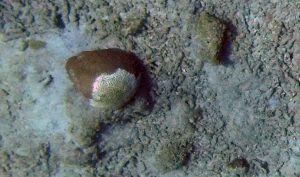 |
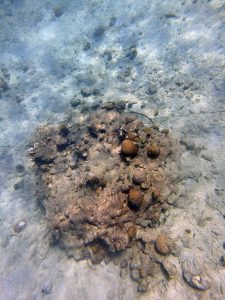 |
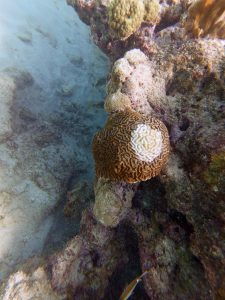 |
AGRRA Rep 11 (Extract)
Date of Observation: 2/12/2023 Submitted 2/13/2023
Reef Type: Other: Breakwaters
Avg Depth: 2 m (estimated)
Water Temp: 24 (estimated)
Reef Name: Two Breakwaters (smaller and larger) at Beachlands, Holetown, Barbados
Location
Reef Type: Other- Two Breakwaters built from basaltic boulders from Nova Scotia
Coral Health Observations: Healthy Corals, Corals with SCTLD
Speces with SCTLD: P.strigosa 6-25 colonies P. clivosa: 1-5 colonies
Protocol: Snorkeling
Describe Observations: There are numerous corals on these breakwaters, mostly P. strigosa, P. clivosa, P asteroides. I swam the seaward sides and noted any OICs (Obviously Infected Corals/presumptive SCTLD). On the smaller breakwater there was only one. On the larger breakwater, 34.
Photos
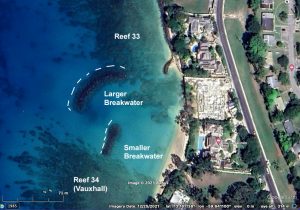 |
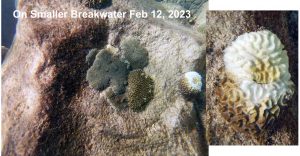 |
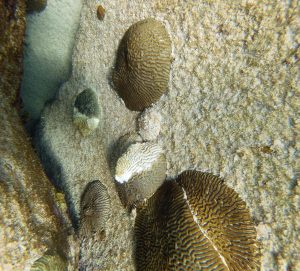 |
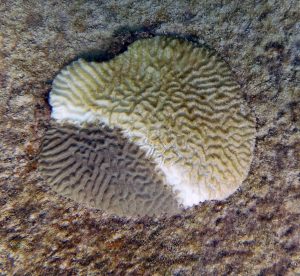 |
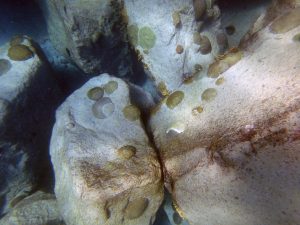 |
AGRRA Rep 12 (Extract)
Date of Observation: 2/5/2023 Submitted 2/14/2023
Reef Type: Fore Reef
Avg Depth 6 m (estimated)
Water Temp 24 (estimated)
Reef Name: Vauxhall
Reef Type: Fore Reef
Coral Health Survey Observations: Healthy Corals, Corals with SCTLD
Diploria labyrinthisformis, 1-5 colonies
O. Annularis, 1-5 colonies
P. Strigosa, 6-25 colonies
Survey protocol: snorkelling
Describe Observed Disease/Bleaching: These sites are on a track that went from just beside “The Wreck” (position A in photo) which is popular with snorkelling boats and a site of many infected corals as previously reported, south tp Pos B by another piece of the wreck (with fewer corals, not frequented by snorkelling boats0, and then further south to a permanent mooring./surface float. The predominant current is southwards. There is a lot of O. annularis here about 6 m depth, it seems uninfected except on a specimen at Position B (in photos). In total there were 7 sites where there were clusters of infected corals, a few places where just one coral was infected (presumptive SCTLD), mostly it appeared, P. strigosa.
Photos
 |
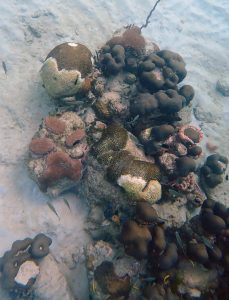 |
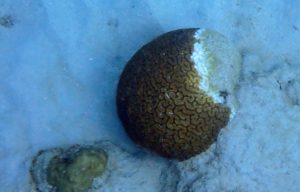 |
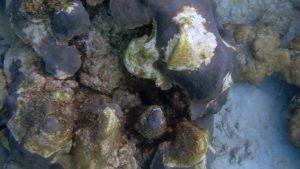 |
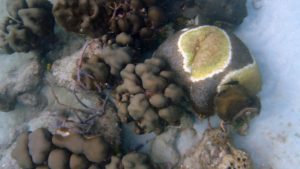 |
AGRRA Rep 13 (Extract)
Date of Observation: 2/15/2023 Submitted 2/18/2023
Reef Type: Other: Backreef to Forereef as shown in photo 1
Abg Depth 2.5 m (estimated)
Water Temp 24 (estimated)
Reef Name: Scientific Zone, Barbados Folkstone MPA, Reefs 29 & 30 (Maclean & Oxenford, 2016)
Coral Health Survey Observations: Healthy Corals, Corals with SCTLD
D. labyrinthiformis, M. cavernosa, P. strigosa each with 1-5 colonies
Survey Protocol: Snorkelling, locations approximate
Describe Observed Disease/Bleaching: I swam the edges of 2 adjacent fringing reefs as shown in first photo, depths 1 to circa 5-7m. These are highly degraded reefs, very low coral cover and most of what’s there doesn’t “look healthy” but few with overt disease except: 3 P. strigosa with presumptive SCTLD, (2 in photo), 1 D. labyrinthiformis possible SCTLD, and 1. M. cavernosa with presumptive SCTLD.
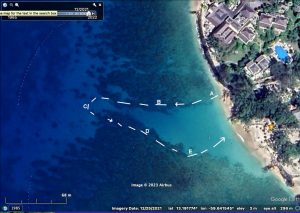 |
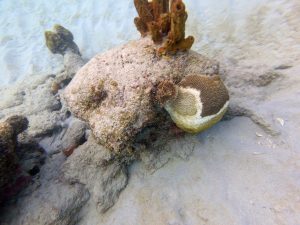 |
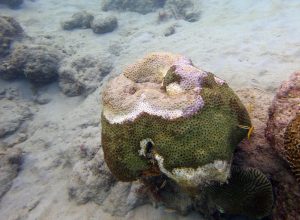 |
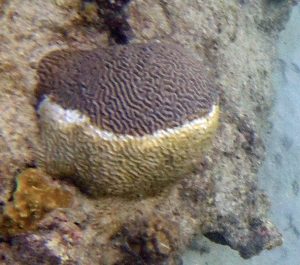 |
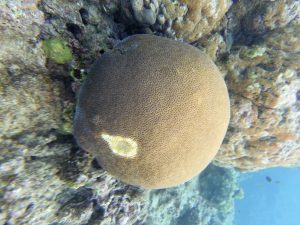 |
AGRRA Rep 14 (Extract)
Date of Observation: 2/15/2023 Submitted 2/18/2023
Reef Type: Breakwater
Abg Depth 1.5 m (estimated)
Water Temp 24 (estimated)
Reef Name: Nearshore Breakwater, Holetown, Barbados
Location
Coral Health Data Entry Survey Observations: Healthy Corals, Corals with SCTLD (possibly, or WPD)
Species: P. strigosa 6-25 P. clivosa 1-5
Survey Protocol: Snorkelling, proceeded from north end to south end, seaward side. Photographed every Obviously Diseased Coral, and provide many frames showing relative abundance diseased, not diseased.
Describe Observations: Most corals appear to be P. strigosa and P. clivosa, with most diseased corals being P. strigosa. A larger set of photos (~70) can be accessed via www.versicolor.ca/vauxhall , Example # 3.
Photos
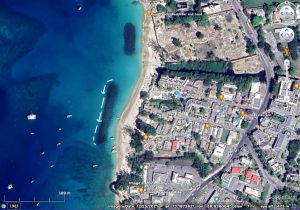 |
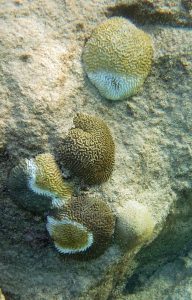 |
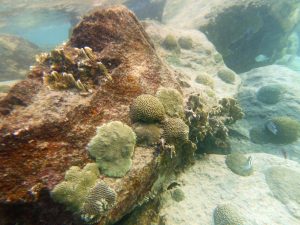 |
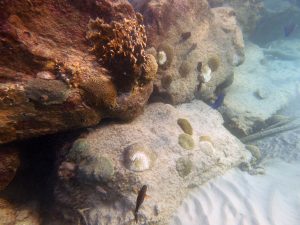 |
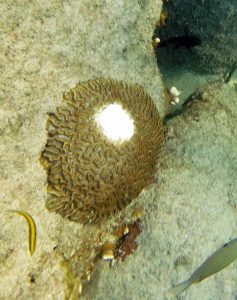 |
AGRRA Rep 15 (Extract)
Date of Observation: 2/20/2023 Submitted 2/20/2023 Resubmitted Feb 26, 2023.
Reef Type: Fore Reef
Avg Depth 3 m (estimated)
Water Temp 24 (estimated)
Reef Name: Vauxhall
Location:
Reef Type: Fore Reef on Wreck
Coral Health Data Entry Survey Observations: healthy corals, corals with SCTLD (presumptive), corals with recent mortality
Species: D. labyrhinthiformis, O annlularis, P. strigosa, S. siderea
Survey protocol: Snorkelling over wreck, compare with photos taken on Jan 15, 2023
Describe Observed Disease/Bleaching: There are 3 sets of comparisons attached, showing changes in particular corals over 36 days on a corner of a wreck; presumptive SCTLD but could be WPD or other. I: shows changes over this period in two specimens of P. strigosa (pls confirm ID); II shows changes over this period in (a) O. annularis – not much if any change; (b). D. labyrinthiformis (pls confrim ID) going from initial infection to almost complete infection; III Of note is a specimen of S. siderea, some light infection on Jan 15 to mostly dead on Feb 20.
AGRRA Rep 16 (Extract)
Date of Observation: 2/22/2023 Submitted 2/23/2023
Reef Type: Fore Reef
Abg Depth 2.5 m (estimated)
Water Temp 24 (estimated)
Reef Name: Vauxhall
Location:
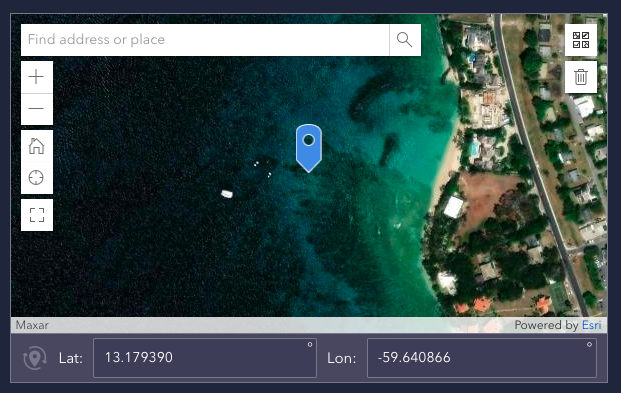
Survey observations: Corals with SCTLD (P. clivosa & P strigosa, 1 each)
Survey Protocol: snorkelling
Describe Observations:
Repeat observations of same corals examined on Jan 21, 2023. Both sets of photos shown.Ist coral by sea-fan I am calling P.clivosa, but needs confrim (not P. strigosa?) Second one appears to beP strigosa. Photos show the advance of the disease (WPD or SCTLD) over one month. (I submitted a report on Jan 23 showing the same corals.)
Photos
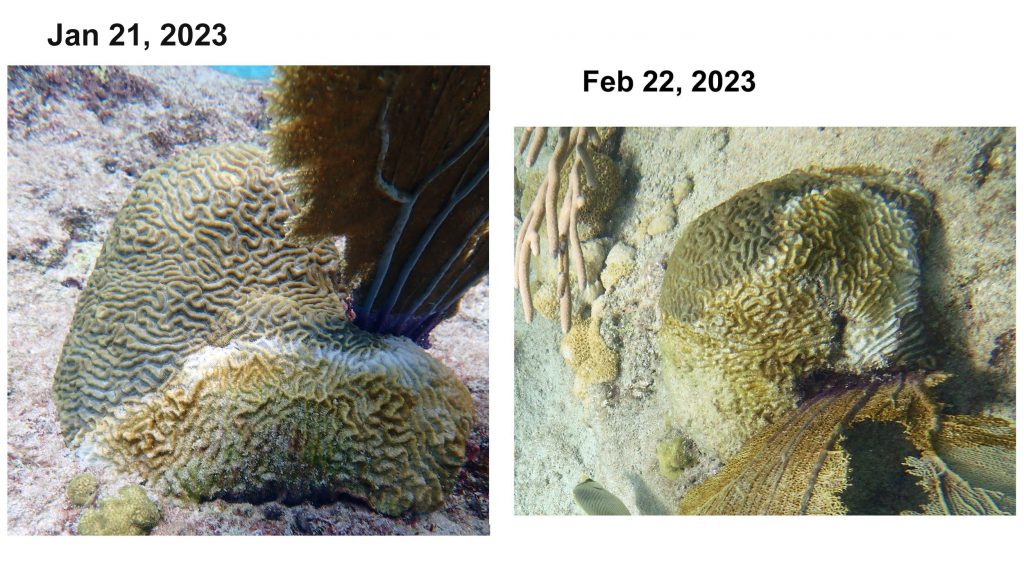
AGRRA Rep 17 (Extract)
Date of Observation: 2/22/2023 Submitted 2/23/2023 but not on AGRRA map on Feb 26.
Reef Type: Fore Reef
Avg Depth 5 m (estimated)
Water Temp 24 (estimated)
Reef Name: Vauxhall – The Wreck
Location
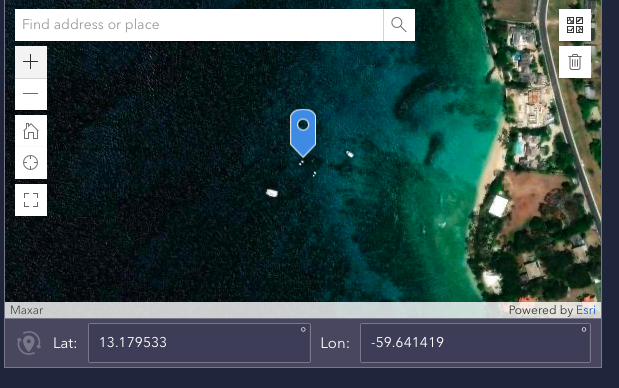
Reef Type: fore Reef /wreck
Coral Health Data Entry Species – M. cavernosa, P. clivosa, P. strigosa, S. siderea
Protocol: Snorkelling Depths and water temperature are estimated
Describe Observations: Corals on west (deeper) end of The Wreck, south side, observed on Jan 14 2023 and Feb 22, 2023.
Three sets of photos Panel 1 Coral A. P. clivosa – not much if any infection both dates; Coral B: small S. siderea, some infection Jan 14 to about 60% on Feb 22; CoralC P. strigosa initial infection in 2 patches Jan 14 to completely covered, dead Feb 22.
Panel 2 Coral A: P.strigosa, about 40% infected Jan 14 to completely covered, apparently dead Feb 22. Coral B appears to be M. cavernosa, not infected both dates. Coral C appears to be small S. siderea, not infected Jan 14 to about 50% on Feb 22. Coral D.appears to be P. clivosa, not infected both dates.
Panel 3: Smaller scale photo, shows about a dozen corals. Corals A,D,F, H prob P. strigosa 25-70% infected on Jan 14, all completely covered/dead on Feb 22
Photos:
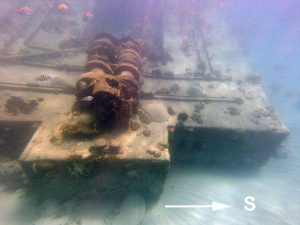 |
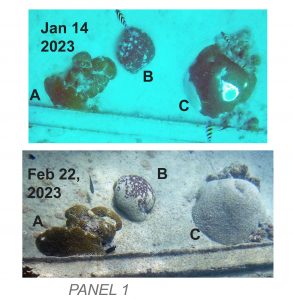 |
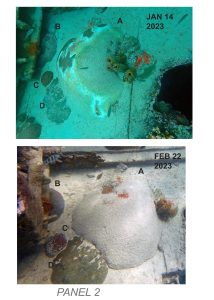 |
 |
AGRRA Rep 18 (Extract)
Date of Observation: 2/24/2023 Submitted 2/25/2023
Reef Type: Fore Reef-Wreck
Abg Depth 3 m (estimated)
Water Temp 24 (estimated)
Reef Name: Vauxhall – The Wreck
Location
Species
P. clivosa, P. strigosa, S. siderea, D. laburinthisformis
Procedure: snorkelling
Comments: 4 photos with the same coral or group of corals on Jan 15, 2023 and on Feb 24, 2023 illustrate progression of the disease, whatver it is!. There are more photos in this series available, see www.versicolor.ca/vauxhall for the link
Photos
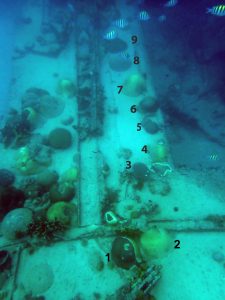 |
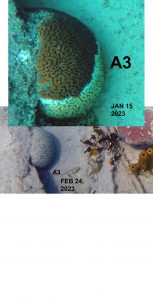 |
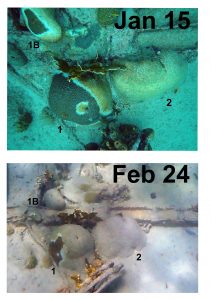 |
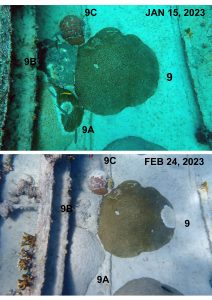 |
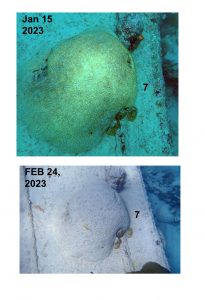 |
AGRRA Rep 19 (Extract)
Date of Observation: 2/25/2023 Submitted 2/26/2023.
Reef Type: Fore Reef
Abg Depth 3 m (estimated)
Water Temp 24 (estimated)
Reef Name: Vauxhall
Location:
Coral Health Survey Observations: Corals with SCTLD, Other Disease
Survey protocol: snorkelling, temp. depth estimated
Species: O annularis
Comments: Diseased O. annularis, disease for ID. I have seen very little diseased O. annularis overall
AGRRA Rep 20 (Extract)
Date of Observation: 2/25/2023 Submitted 2/26/2023.
Reef Type: Fore Reef
Avg Depth 7 m (estimated)
Water Temp 24 (estimated)
Reef Name: Vauxhall
Location:
Coral Health Survey Observations: Corals with SCTLD, Other Disease
Species: O. annularis
Comments: Could be yellow blotch disease as illustrated by Bruckner 2020 PDF doc. Or SCTLD?
AGRRA Rep 21 (Extract)
Date of Observation: 3/8/2023 Submitted 3/9/2023.
Reef Type: Fore Reef
Avg Depth 7 m (estimated)
Water Temp 24 (estimated)
Reef Name: Vauxhall
Coral Health Survey Observations: Healthy Corals, Corals with SCTLD (presumptive)
Species: O. annularis
Protocol: Snorkelling: Snorkelling, water temp and depth estimated
Comments: A comparison pics show one colony of O. annularis on Feb 5, 2023, and again on Mar 8 2023. Another photo is a closeup of the disease front on Feb 5, 2023 and appears to show a zone of sloughing off tissue. Finally a photo shows the dense colonies of A annularis in this area on Feb 5. I have been keeping an eye out for infected O annularis, this is the only one I have seen that looks like SCTLD; 99%+ of the colonies in this area and closer to shore remain free of disease
Photos:
 |
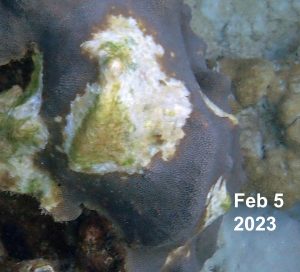 |
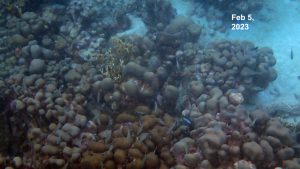 |
AGRRA Rep 22 (Extract)
Date of Observation: 3/26/2023 Submitted 13/27/2023.
Reef Type: Fore Reef
Avg Depth 7 m (estimated)
Water Temp 24 (estimated)
Reef Name: Vauxhall
Uninfected and infected O. annularis “More signs of infected A. annularis. Still not common. Downstream from highly infected corals on a popular snorkelling Wreck”
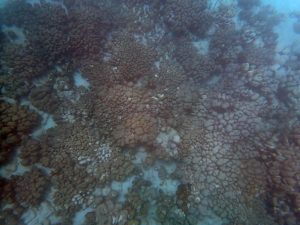 |
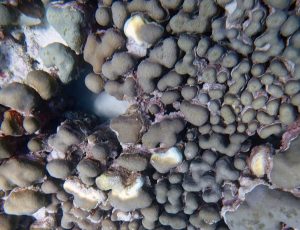 |
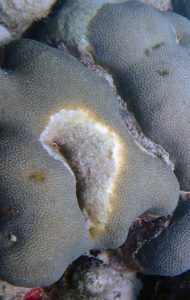 |
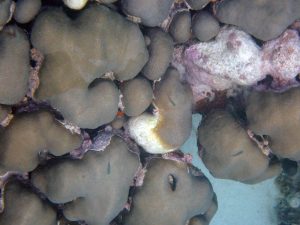 |
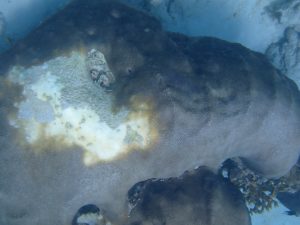 |
AGRRA Rep 23 (Extract)
Date of Observation: 3/28/2023 Submitted 4/1/2023.
Reef Type: Reef Crest
Avg Depth 1 m (estimated)
Water Temp 24 (estimated)
Reef Name: Vauxhall
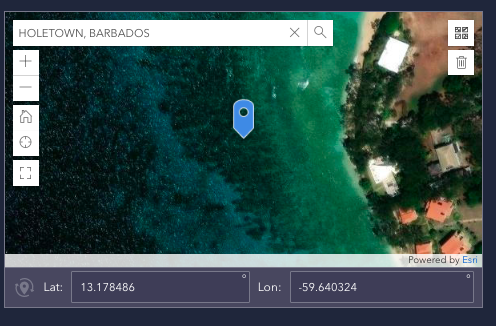
Survey Protocoal:snorkelling, several locations in the Reef Crest zone. Depth and temperature approximate
Comments; Looks like SCTLD on O. annularis. First time I have seen it in the Reef Crest zone of this reef; I had seen some earlier on O. annularis on the Reef Front.
Photos
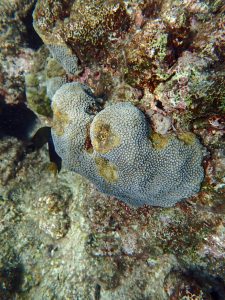 |
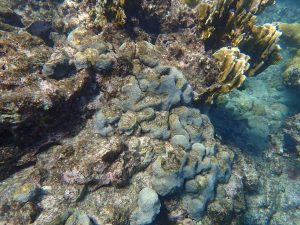 |
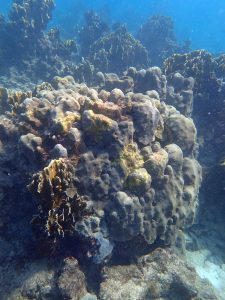 |
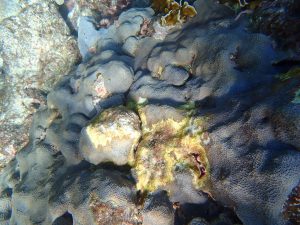 |
AGRRA Rep 24 (Extract)
Date of Observation: 4/6/2023 Submitted 4/9/2023.
Reef Type: Patch Reef
Avg Depth 6 m (estimated)
Water Temp 24 (estimated)
Reef Name: Holetown area
Location: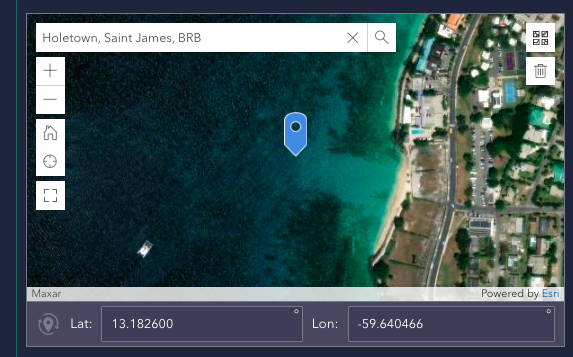
SCTLD Observations: Corals with stony coral tissue loss disease: D.cylindricus (pillar coral): 1 colony, infected with presumptive SCTLD
Other Species
If you saw a species with SCTLD that is not in the list above, please tell us what species you observed and the count if known: P. strigosa, common & most of those in the area were infected
Survey Protocol: Snorkelling, dpeth and temperature estimated. Location by recognition of position onshore and features on Google Earth. Prob +/-2 m
Describe Observed Disease/Bleaching: Diseased pillar coral, small colony in area of brain corals, sponges, stinging coral on otherwise sandy bottom. I have been monitoring pillar corals at Vauxhall Reef (circa 300 m to the south of this area) where they are quite common, no disease observed there as of yet.
Photos:
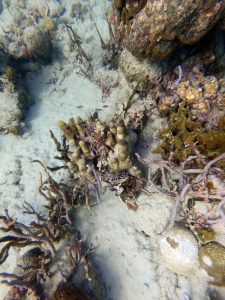 |
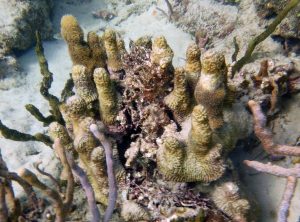 |
All reports on AGRRA of possible SCTLD in Barbados
As of Apr 17, 2023, there were
– 3 reports of possible occurrence on deep reefs (11 to 30 m) on the west coast of Barbados (those made on Nov 18, 2022, Dec 1, 2022, Jan 5, 2023 by S Howell and R. Suckoo)
– 2 reports of possible occurrence on the Bajan Queen (shipwreck in Carlisle Bay on the south coast) by M. Alvarado (Jan 1, and Feb 23, 2023)
– 21 reports of its possible occurrence within the Folkstone MPA by D. Patriquin (Jan 11 to Apr 4, 2023.
As of Apr 17, 2023, the AGRRA group had still not confirmed the presence of SCTLD is Barbados.
AGRRA Rep 25 (Extract)
Date of Observation: 3/1/2023 Submitted 4/18/2023.
Reef Type: Fore Reef
Avg Depth 4 m (estimated)
Water Temp 24 (estimated)
Reef Name: MPA Reef 33
Snorkelling. depth and temperature approximate
Photo of one specimen of D. labyrinthiformis with multifocal lesions
AGRRA Rep 26 (Extract)
Date of Observation: 3/17/2023 Submitted 4/18/2023.
Reef Type: Fore Reef
Avg Depth 4 m (estimated)
Water Temp 24 (estimated)
Reef Name: MPA Reef 32
Location
Snorkelling. depth and temperature approximate
Photo of 2 specimens of P. strigosa, each with clear multifocal lesions. I hadn’t been seeing multifocal lesions on P. strigosa in this area earlier on.

